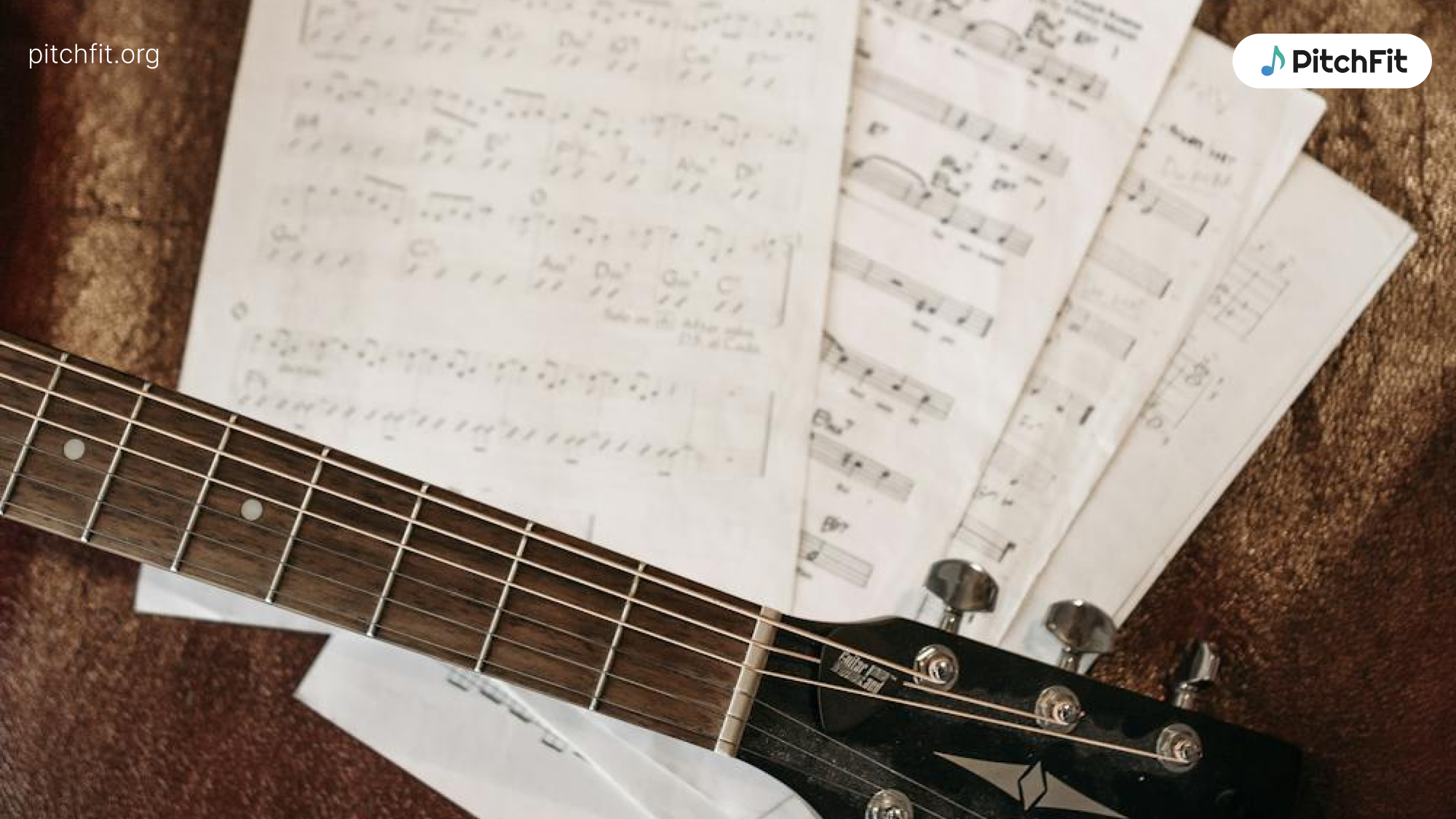If you're looking to improve your musicianship, interval ear training is a powerful tool that can elevate your ability to play by ear, sight-sing, compose, and improvise. Whether you're a beginner in ear training or an experienced musician, mastering intervals – the distances between notes – will give you greater control over your instrument and help you understand music on a deeper level.
This guide explores what intervals are, why they matter, and how to train your ears to recognize them, offering practical exercises, tips for practice, and real-world applications.
Developing strong aural skills through training such as interval training allows musicians to recognize pitch relationships and melodic structures by ear, which can help when composing, improvising, playing with others and sight singing.
What Are Intervals and Why Do They Matter?
At its core, an interval in music is the distance between two notes. This concept might seem simple, but it forms the foundation of everything from melodies to complex harmonies. It can help us follow a new melody quickly when playing by ear, make good chord choices and improve our improvised solos by allowing us to play what we hear in our head more accurately and confidently.
Imagine a piano keyboard: pressing one key and then another creates an interval. This distance can be as small as moving to the very next key or as large as skipping several keys. Every melody, chord, or harmony we hear is built using intervals, making them one of the most important elements in music theory.
- The distance between the notes C and D is called a "major second."
- The distance between C and E is a "major third."
These relationships are key to understanding how music is structured. Let’s explore how to recognize and use them in our everyday practice.
Types of intervals
Intervals can be categorized in several ways:
- Quality: Some intervals are called perfect (like unison, fourths, fifths, and octaves), while others are major or minor (such as seconds, thirds, sixths, and sevenths). These intervals can also be altered, becoming augmented (larger) or diminished (smaller).
- Size: Intervals can either be simple (within one octave, like a perfect fifth) or compound (larger than an octave, like a major tenth). A compound interval spans more than one octave, adding richness and complexity to melodies and harmonies.
- Direction: An interval can be either ascending (where the second note is higher than the first) or descending (where the second note is lower).
Recognizing different interval types – such as perfect, major, minor, augmented, and diminished intervals – helps musicians distinguish the emotional qualities these intervals bring to music, from stability to tension and resolution.
Understanding intervals can help us when mastering scales. Scales are built from a series of intervals, such as whole steps and half steps, that give each scale its unique sound. Recognizing these intervals can help you play scales more fluidly and understand their role in music theory.
There are many lists of references to songs which use specific intervals. Finding some examples of songs you are already familiar with and spending some time listening to, will help give you context and reference points when learning the different names of each interval type.
Why intervals matter
Understanding intervals is essential for developing our aural skills, and can also lead to greater satisfaction when playing, as having strong interval knowledge can help us reach our note choices swiftly and more accurately.
- Training your ear: Learning to recognize intervals is essential for ear training, enabling you to identify the notes you hear and play music by ear.
- Creating melodies: Melodies consist of notes spaced by specific intervals. Knowing these intervals helps you learn and play melodies with greater accuracy and speed.
- Building chords: Chords are built by stacking notes at specific intervals. Understanding intervals is key to creating and playing chords accurately.
- Helping singers: Singers rely on intervals to move from one note to another. Interval recognition helps with both sight-singing and singing by ear, improving pitch accuracy.
- Forming harmony: Different intervals produce different types of harmonies, giving music depth and emotional impact.
- Composing music: Composers use intervals to create tension and resolution, shaping the emotional journey of a piece.
In short, intervals connect the notes together. The more you understand intervals, the better equipped you’ll be to play, sing, and write music.
What Is Interval Ear Training?
Interval ear training is the focused practice of learning to identify the distance between two notes just by listening. This helps you develop the ability to recognize intervals instantly and accurately – whether they are close together or far apart.
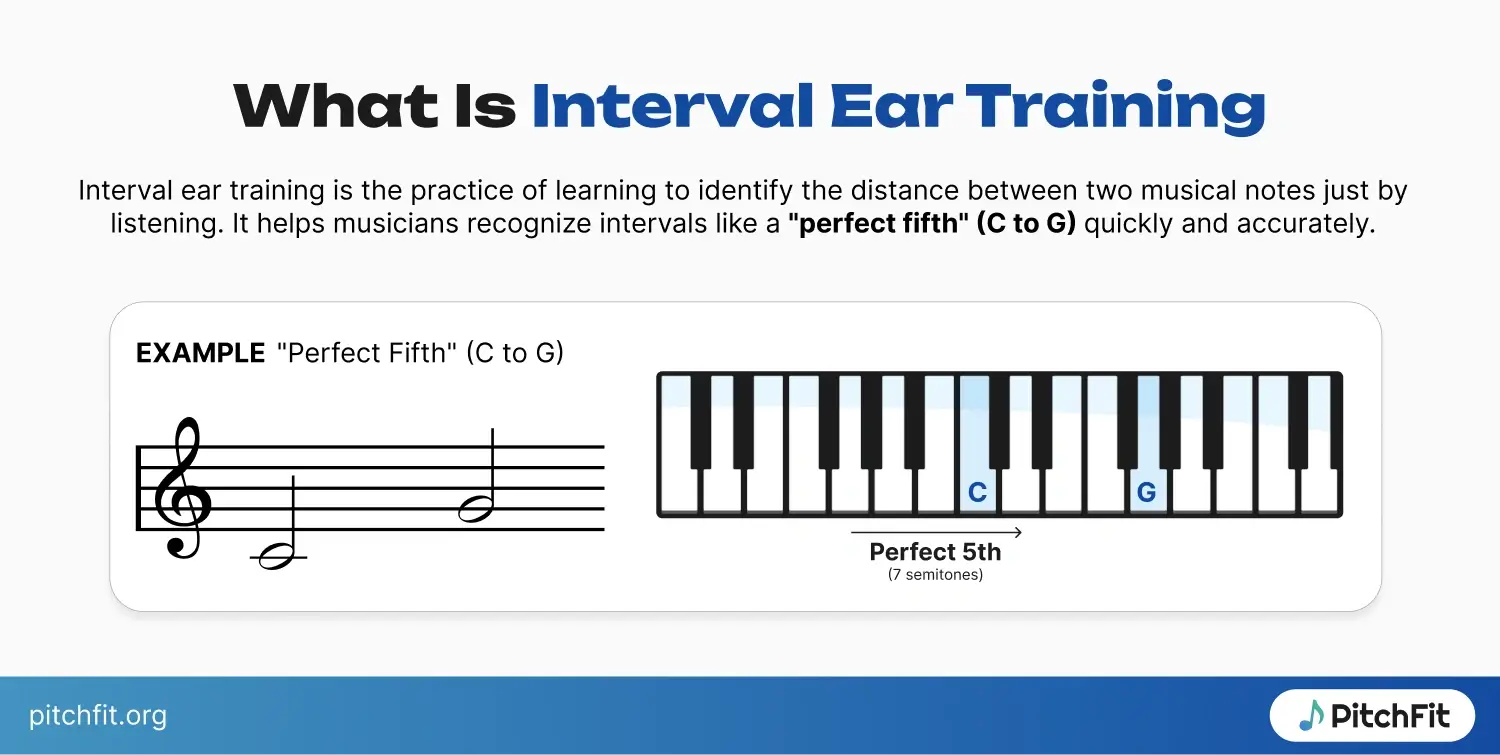
For example, if you hear the notes C and G, interval ear training helps you recognize that the distance between them is a "perfect fifth." Over time, this skill allows you to pick out melodies, harmonies, and chords simply by ear, which is incredibly useful for musicians.
Musical interval identification ear training focuses on recognizing the distance between two pitches by ear. This training sharpens your ability to pick out specific intervals in melodies and harmonies, enhancing your overall musicianship.
Difference between interval ear training and other ear training methods
Interval ear training focuses solely on recognizing the pitch distance between two notes, but it’s only one part of overall ear training. Here’s how it compares to other methods:
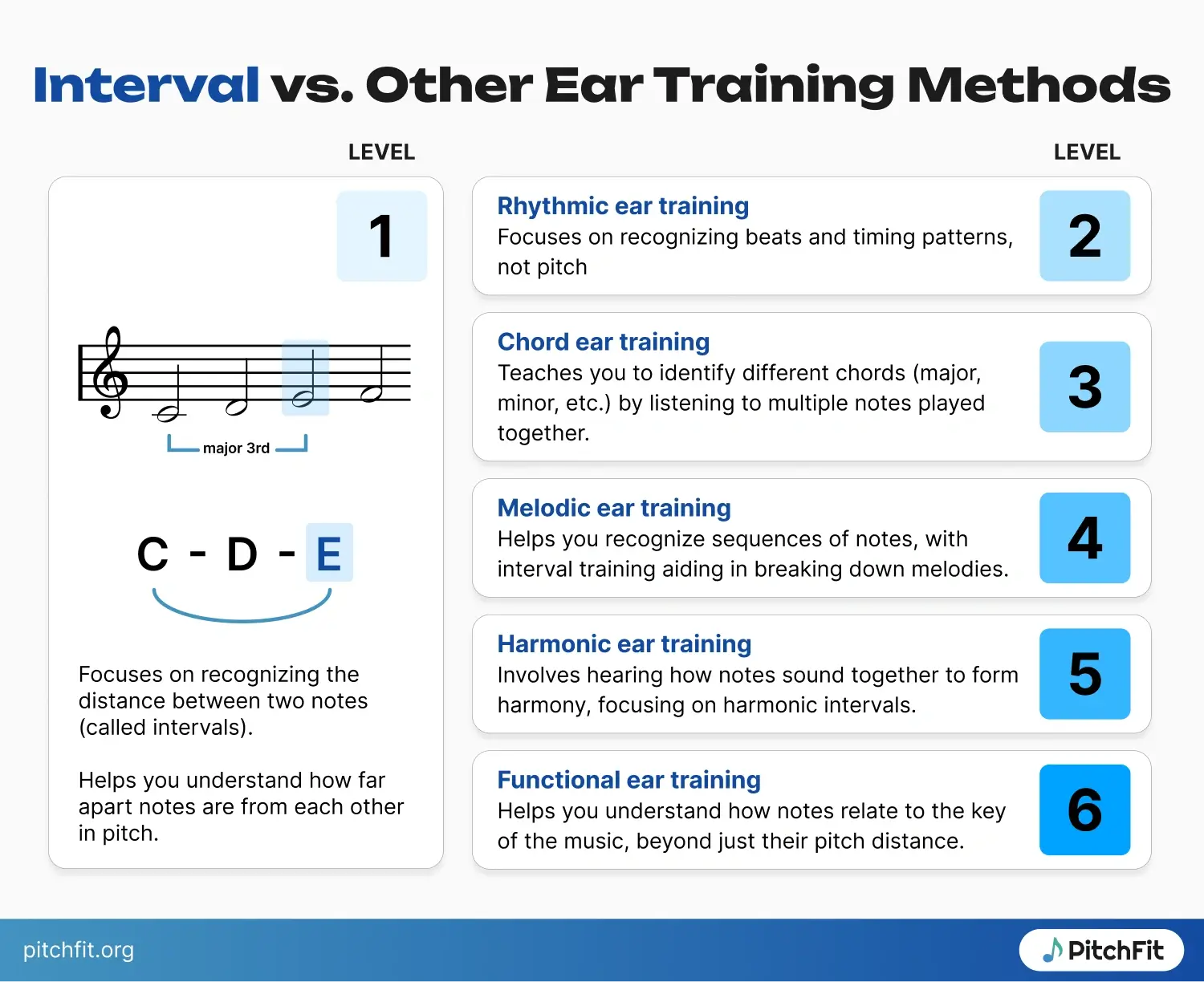
- Rhythmic ear training: Instead of focusing on pitch, rhythmic ear training deals with recognizing beats and timing patterns.
- Chord ear training: Chord ear training teaches you to identify different types of chords, such as major, minor, diminished, and seventh chords. Unlike interval ear training, this method involves listening to several notes played together.
- Melodic ear training: In melodic ear training, you work on recognizing entire sequences of notes. Interval ear training can support this by helping you break melodies down into their interval components.
- Harmonic ear training: This method focuses on recognizing how notes interact when played together, forming harmony. Harmonic intervals refer to the pitch relationship between two notes played simultaneously, creating harmony. Understanding harmonic intervals is essential for identifying chords and the emotional impact of different harmonies in music.
- Functional ear training: Functional ear training teaches you to hear how notes relate to a tonal center (the key of the piece). Unlike interval ear training, functional ear training benefits you by helping you understand a note’s role in a piece of music, rather than just its distance from another note.
Think of interval ear training as learning to recognize the distance between steps on a staircase by feel. Once you master this, other ear training methods, like rhythmic or harmonic ear training, become easier and more intuitive.
Why Is Interval Ear Training Effective?
Interval ear training is highly effective because it focuses on one of the most fundamental aspects of music – pitch relationships between notes. Here’s why this training is so beneficial for musicians:
- Play by ear: When you can recognize intervals, you can learn songs without needing sheet music. You’ll be able to figure out melodies just by listening and identifying the intervals between notes.
- Sight-singing: Singers can pitch notes more accurately by sight. Interval ear training sharpens your ability to hit the right notes confidently during performances
- Improve musical memory: As you train your ear to recognize intervals, you’ll find it easier to remember songs and melodies. This is especially helpful when trying to recreate a tune you’ve heard.
How to Train Your Ears to Recognize Intervals
Now that you understand the importance of intervals, let’s dive into how to train your ear to recognize them.
Learning intervals is foundational to improving your aural skills. By familiarizing yourself with common intervals, such as seconds, thirds, and octaves, you’ll develop an intuitive sense of pitch relationships that can be applied in both performance and composition.
There are several proven methods to train your ear, and combining them will give you the best results. As you try these different methods of learning, pay attention to what makes the most sense to you. This will help you develop your personal method and practice routine for mastering intervals.
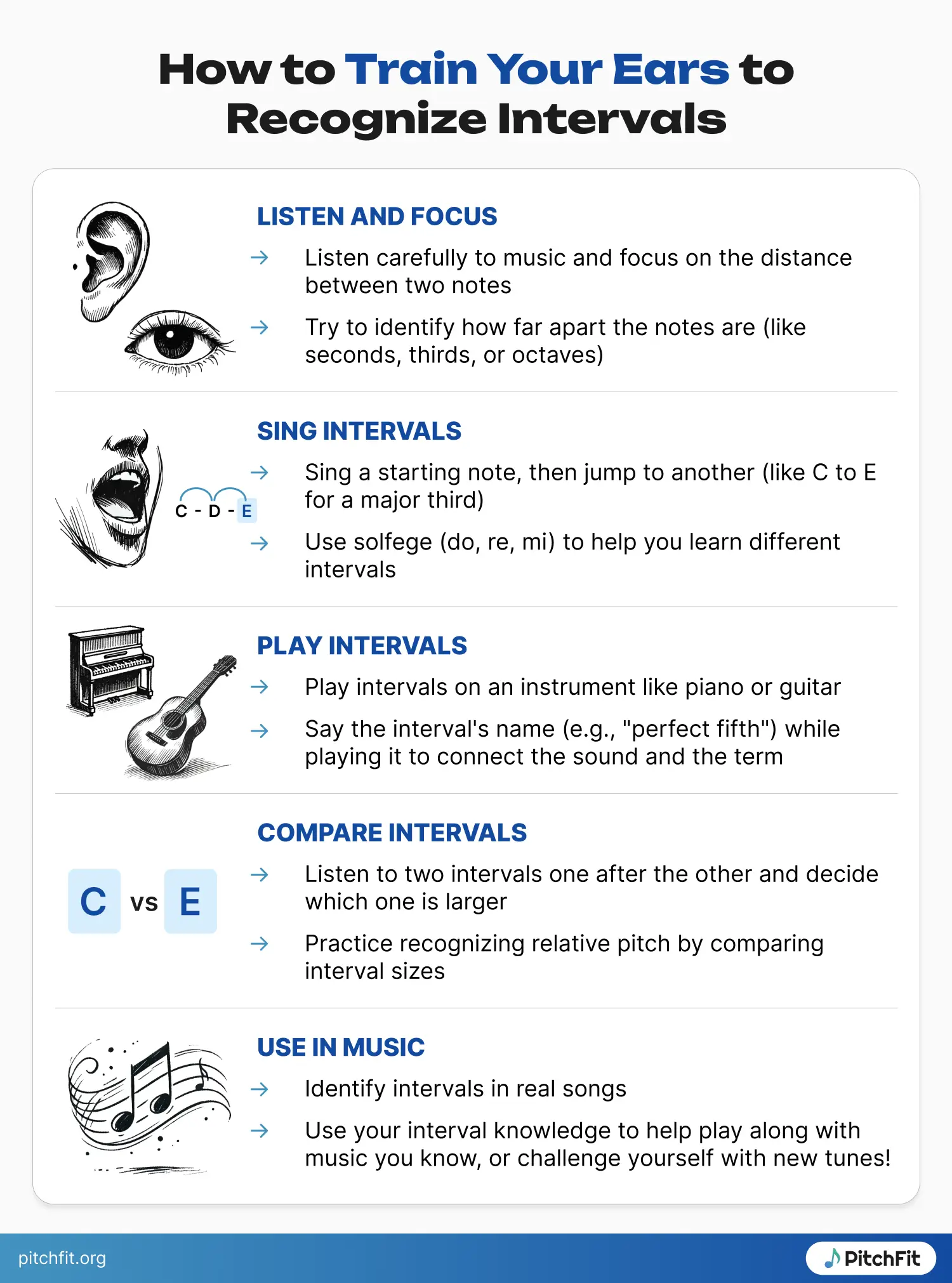
Listening and singing practice
- Listening exercises: Actively listen to music and focus on the intervals between notes. Try to identify how far apart the notes are. This helps your ear get used to recognizing intervals naturally. Using reference songs can help when starting out with these exercises.
- Singing intervals: Sing intervals out loud to internalize how they sound. For example, sing a C note, then try to jump to an E to practice a major third. This builds muscle memory for how intervals sound and feel.
- Interval singing with solfege: Use solfege syllables (do, re, mi, etc.) to sing intervals and associate each interval with a syllable. This helps solidify your understanding of intervals.
Instrument practice
- Playing intervals: Play intervals on an instrument like the piano or guitar. Start by stating the name of the interval and then playing it. Connecting the sound of an interval with its physical placement on your instrument helps reinforce your learning.
- Interval-based ear training zeroes in on listening for the relationship between two notes, allowing musicians to quickly identify the distance between them. Unlike other forms of ear training, this approach focuses solely on intervals, making it a foundational skill for all musicians.
- Interval chain exercise: Start by playing a note, then move to another note at a specific interval away, and continue building a "chain" of intervals. For example, start on C, move up a major third to E, then up a perfect fourth to A, and so on.
Interval comparison and dictation
- Interval comparison: Listen to two intervals back-to-back and determine which one is larger. This sharpens your sense of relative pitch and helps you better understand interval relationships.
- Interval dictation: Listen to a series of intervals and write them down using musical notation. This exercise combines ear training with music theory and improves your ability to transcribe what you hear.
Interval recognition in musical context
Once you’ve developed your interval recognition skills, the real fun begins! We can now start applying them to real musical situations:
- Recognizing intervals in music: Listen to short musical phrases and identify the intervals within them. This helps you bridge the gap between isolated interval practice and recognizing intervals in actual songs.
- Use your knowledge to play along: Now that we can recognise them, use your interval knowledge to help you play along to songs you know and love. Notice how the practice has helped to figure out the shape of the melody. Once familiar songs become achievable, why not try songs you are less familiar with, or even recordings of improvised solos!
Key Steps to Get Started with Interval Ear Training
To effectively train your ears, it’s important to follow a structured approach. Here are some key steps to help you get started:
- Start simple: Begin with smaller, more common intervals like seconds and thirds. Once you can easily identify these, move on to larger intervals like fifths and octaves.
- Use reference songs: Associating intervals with familiar tunes makes them easier to remember. For instance, the first two notes of "Here Comes the Bride" form a perfect fourth.
- Practice regularly: Like any skill, ear training improves with consistent practice. Dedicate a few minutes each day to listening, singing, or playing intervals. Apps like EarMaster or Perfect Ear provide exercises to keep you engaged.
- Use interval chains: Play or sing a sequence of intervals in a chain, starting from one note and progressing through different intervals. This will help reinforce your interval recognition in a progressive way.
- Compose two-note melodies: Create short melodies using only two notes at specific intervals. This helps you internalize the sound of each interval in a musical context rather than in isolation.
Example exercise: step-by-step guide
Here’s a simple interval ear training exercise you can try today:
- Choose an interval: Start with a perfect fourth.
- Find a reference song: Use familiar tunes, like "Here Comes the Bride" or “Amazing Grace,” which start with a perfect fourth.
- Listen and sing: Play the interval and sing it back, using the reference song to guide your ear.
- Test yourself: Listen to different intervals and try to identify which one is the perfect fourth.
Benefits of Interval Ear Training
Mastering interval ear training provides many benefits for musicians. As you build a good routine of practicing interval training, you will notice a variety of advantages it brings to your playing and musicianship.
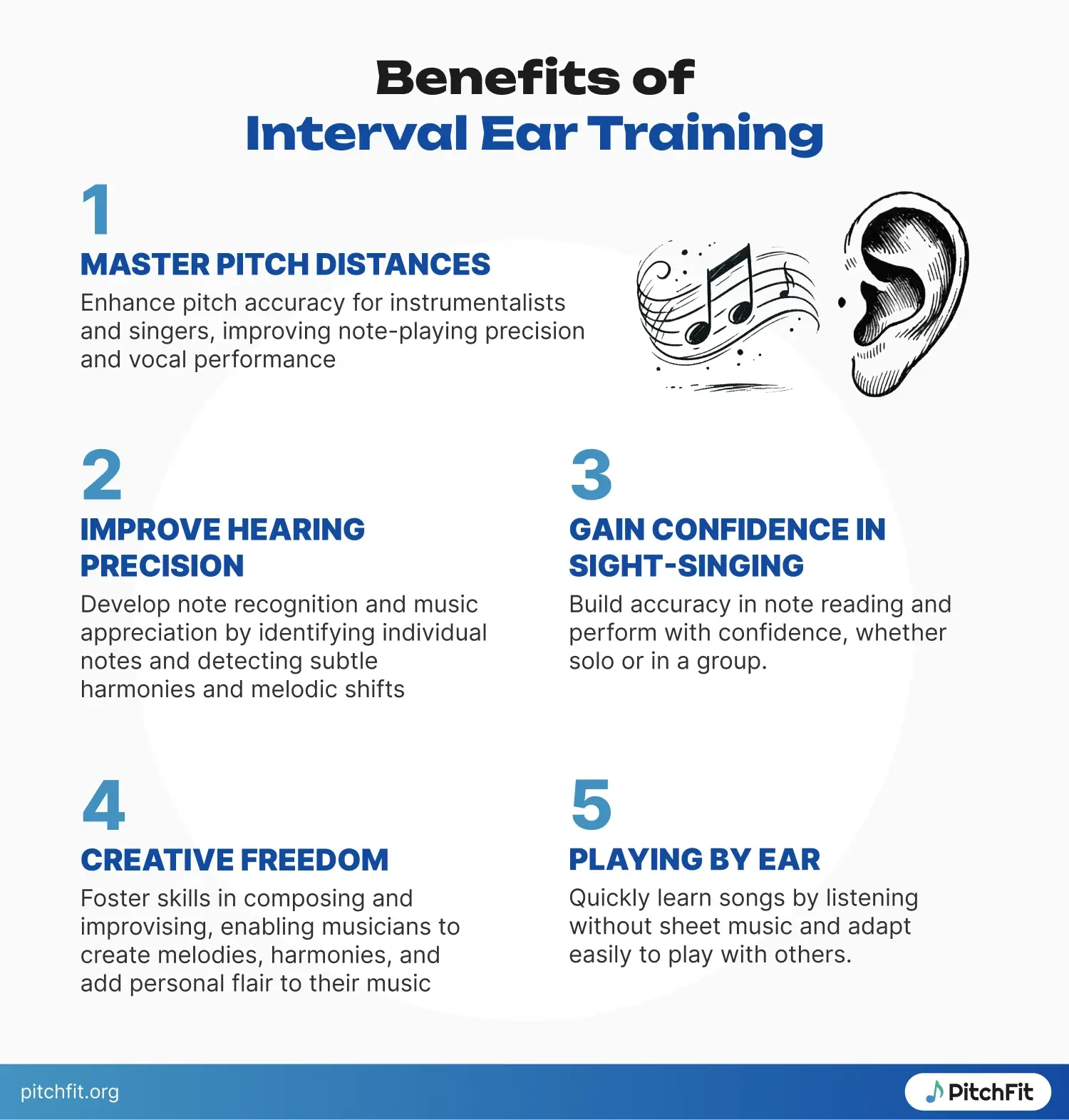
Master pitch distances
- For instrumentalists: Recognizing pitch distances improves your ability to hit the right notes accurately. This applies to any instrument, whether it’s piano, guitar, or something else.
- For singers: Your pitch will become more precise, helping you improve both sight-singing and singing by ear. You’ll know exactly how far to jump between notes, which improves your vocal performance.
Improve hearing precision
Interval ear training sharpens your ability to hear specific notes within chords or melodies. This improved hearing has two key benefits:
- Note recognition: You’ll be able to pick out individual notes, even in complex harmonic settings.
- Enhanced music appreciation: As you improve your ear, you’ll start noticing the finer details in the music you listen to, from subtle harmonies to intricate melodic shifts.
Gain confidence in sight-singing
For singers, interval ear training helps you read music accurately and sing with more confidence:
- Accurate music reading: You’ll know exactly how each note should sound, which makes reading music much easier.
- Confident performances: Whether you’re performing solo or in a choir, interval ear training will give you the confidence to hit the right notes and stay on pitch.
Creative freedom
Once you’ve mastered interval recognition, you’ll have greater creative freedom in your music:
- Composing: Understanding intervals allows you to create your own melodies and harmonies with ease. You’ll have a better grasp of how notes relate to each other.
- Improvisation: With strong interval recognition, you’ll be able to improvise on the spot, adding your own flair to a song.
Playing by ear
- Learn songs quickly: Interval ear training makes it easier to figure out songs just by listening. You won’t need sheet music to learn new songs.
- Adapt quickly: If you’re playing with others, recognizing intervals helps you pick up and join in, even if you don’t know the song beforehand.
How Often Should You Practice Ear Training?
The good news is that interval ear training doesn’t require long, exhausting sessions. In fact, it’s the opposite. With the right approach, short, daily practice can produce significant results over time.
Practical tips for creating a routine
When starting out, keep your practice sessions manageable. Here are some tips for building a solid routine:
- Short sessions: Aim for 10 to 15 minutes of ear training per day. Consistent, shorter sessions are more effective than occasional long ones.
- Set specific goals: Focus on mastering one or two intervals at a time. This approach prevents you from feeling overwhelmed and helps you make steady progress.
How much practice is recommended?
You don’t need to practice for hours every day to improve your ear training skills. Find short blocks of time that you can regularly use to practice and commit to them to see the best results.
- Daily practice: Even a few minutes a day can make a big difference. Over time, your ear will become more accustomed to recognizing intervals quickly and accurately.
- Regular review: It’s important to regularly revisit intervals you’ve already learned. Reviewing past material reinforces your understanding and prevents you from forgetting it.
Strategies for incorporating ear training into your routine
Ear training doesn’t have to be a standalone activity. It can easily be integrated into your daily life or instrument practice. Find some fun ways to sneak in some practice, do some listening exercises on the train, play an interval training game while you reheat dinner in the microwave or even build it into your morning routine, just as you would brush your hair or make a coffee.
Here are a few strategies to help you stay on track:
- Use apps during downtime: Take advantage of ear training apps like EarMaster or Perfect Ear while commuting, waiting in line, or during breaks. This helps keep your skills sharp without taking up too much of your time.
- Combine with instrument practice: If you’re already practicing an instrument, integrate interval exercises into your practice routine. For example, play intervals on your instrument and try to identify them by ear.
- Mix it up: Vary your exercises to keep ear training engaging. Some days, focus on interval recognition, while on other days, practice singing or interval dictation.
Conclusion
Interval ear training is a valuable skill that opens up new possibilities in your musical journey. By learning to recognize the distances between notes, you’ll play more confidently, understand music more deeply, and enjoy greater creative freedom. Remember to have fun with this - start at a level that challenges without overwhelming the system. A little bit of training done regularly goes a long way! Whether you’re a beginner or an experienced musician, practicing interval ear training will take your musical abilities to the next level.




